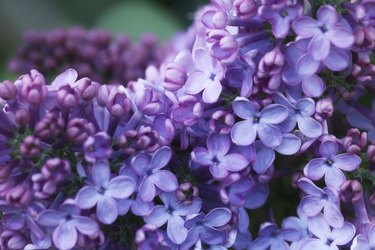
Lilacs (Syringa spp.) are cold-weather perennials native to Eastern Europe and Asia, and they are not the best flowers to grow in Florida, which has a subtropical climate. While their common name is synonymous with a pinkish-purple shade, lilacs come in many shades of pink and purple, and some lilacs are white. Lilacs are hardy in U.S. Department of Agriculture zones 3 to 10. Because they require a period of cold-induced dormancy in order to produce new blooms, these ornamentals do not grow well in warm climates that have mild winters.
Popular Lilac Varieties
Video of the Day
There are some 1,000 lilac varieties, the largest of which grow in tree form and include the Japanese tree lilac (Syringa reticulata), which can reach heights of 30 feet and produces white blooms. The common lilac (Syringa vulgaris), by far the most popular variety in the United States, is a shrub that has a maximum height of 12 feet and purple flowers. Other shrubs in this range include the early lilac (Syringa oblata), which can also be 12 feet tall and produces pinkish-purple blooms in April and May, before other species. The early lilac is a good option if you want fall color, as it is the only species to develop such color.
Video of the Day
The littleleaf lilac (Syringa pubescens subsp. microphylla) can grow to be 6 feet tall but rarely exceeds 5 feet. As its name suggests, the leaves and flowers of this lilac variety are smaller than most. If you are looking for an even smaller lilac bush, consider the Palibin dwarf Korean lilac (Syringa meyeri 'Palibin'), which tends to be 4 to 5 feet tall. Its flowers are a pale pink color.
Lilac Culture Needs
Plant lilac trees and shrubs where they can receive six hours of sun a day, which is considered full sun. Light shade is acceptable, but too much shade can inhibit flower production. Lilacs like soil that is slightly acidic to slightly alkaline. If the soil is too acidic, you will need to amend it to bring up the pH. The soil should be rich in organic matter and should drain well. Lilacs rarely require supplemental watering.
Lilac bushes are low-maintenance and will also perform just fine even if you neglect them. You should, however, prune lilacs immediately after flowering so as not to interfere with new buds. Remove faded lilac flower panicles promptly before seed sets for more profuse blooms the following year.
Best Flowers to Grow in Florida
Instead of planting a lilac bush in Florida, where it is unlikely to produce its prized flowers, consider ornamentals that can withstand hot summer temperatures. Choices for annuals include zinnias as well as the wishbone flower (Torenia fournieri), which will thrive in both shaded and sunny areas and comes in a variety of colors, including yellow, pink, purple and white.
Perennial flower options for a Florida garden include pentas (Pentas lanceolata), which are available in white, pink and red. If you live near the coast, consider lantanas (Lantana spp.), which can handle salt water. Avoid the common lantana (Lantana camara), however, as it can become invasive. Scarlet salvia is also a good perennial for subtropical regions.
- Cornell Cooperative Extension of Chemung County: Growing Lilacs
- Better Homes & Gardens: 6 Little-Known Lilac Facts That May Surprise You
- Missouri Botanical Garden: Syringa reticulata
- Better Homes & Gardens: Lilac Shrubs
- Missouri Botanical Garden: Syringa oblata
- Missouri Botanical Garden: Syringa meyeri 'Palibin'
- University of Florida IFAS Gardening Solutions: Summer Bedding Plants